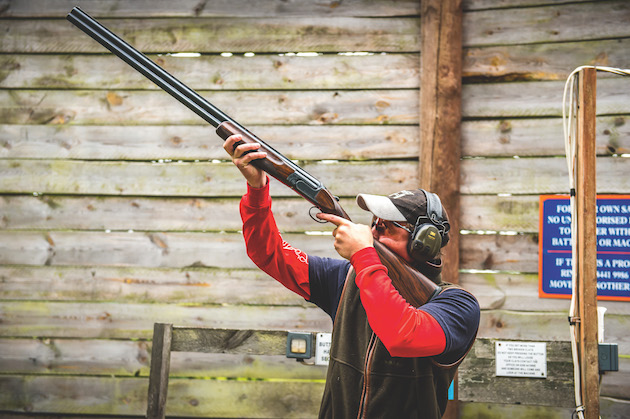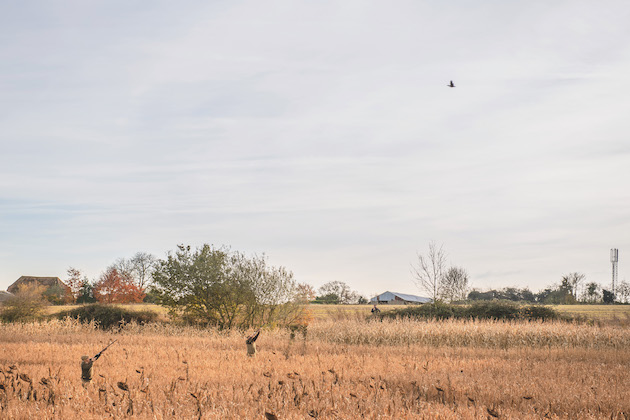We've all heard some well-meaning amateur shout 'you're behind them, mate' - but they may be entirely wrong, says Simon Reinhold
You will probably have heard it at some point on a clay ground from the back of the cage: “You’re behind it, mate.” While it is meant well, there is little more irritating than this kind of unsolicited comment. Another supposedly self-evident truth that is trotted out repeatedly on a game day is “You don’t miss ’em in front”. But is it true or are these just lazy stereotype remarks from well-meaning amateurs?
Miss when shooting
If you have spent all summer shooting long battue targets on your local clay ground and are used to seeing a gap between your muzzles and the clay, you may find yourself having to adjust when it comes to game shooting. It is no good simply getting further and further in front of the birds following a miss, thinking that this will fix the issue.
Most instructors on a clay ground will explain the three methods of connecting your shot string to the bird: swing through, pull away and maintained lead. Maintained lead has been employed very successfully by some shooters who rely on an almost superpower-like gift of hand-eye co-ordination, and it can be necessary in certain situations.

There are some top-level US skeet Shots who shoot nothing else and have runs of hits that go into the hundreds, but for most of us it can lead to problems as there is little or no relationship between barrel and bird. If you try maintained lead on driven game you may get lucky but most of the time you won’t.
Pull away — sometimes referred to as ‘the Method’ — starts on the bird and the muzzles accelerate away from it until you are comfortable with your lead picture when you squeeze the trigger. This relationship established between muzzle and bird gives two vital pieces of information to your subconscious: first, you have some idea of how fast the bird is travelling; secondly, you have some idea of its line of flight and angle. This again for game shooting can be successful but you can end up in the weeds as you come to rely too much on deliberate movements and seeing the gap. Once it stops working you try to rectify it with a bigger gap, when what is more likely is that you have stopped your gun swing and poked.

Many clay Shot use the pull-away method but this is less suitable fro game shooting
This leaves us with swing through. The natural fluidity of swing through means it is the method of choice for almost all game shooting because it helps to prevent you measuring.
You sometimes hear the issue of measurement referred to in other sports, particularly tennis, as players ‘getting tight’. The attempt at controlling a shot leads to the very opposite result than the one hoped for. If you fail to appreciate the difference between pulling away from a clay to a pre-judged lead and swinging through you can end up shooting in front without realising it.
Veteran commentator on all things shooting sports Mike Yardley agrees. “Missing in front is far more common than most people think,” he says. “It’s a particular malady for clay shooters transferring to game. The reason for this is the standard clay pigeon travels at 50mph, similar to a pigeon in straight and level flight, but your standard pheasant is usually flying under 40mph and partridges are around 30mph, all dependent on wind, of course.”
Longer barrels
It should be noted that the gun can also make a difference, particularly longer barrels. Mike explains: “I have found that I can shoot driven pheasants well with a 32in 20-bore and when I compared the shooting qualities of a 32in and a 30in gun — and we did this experimentally at one of the London shooting grounds — I found that I was leading birds roughly speaking 10% less than I was aware of with the longer gun. Though this suited driven pheasants, I was perplexed when I got to the clay ground and realised I had to extend my lead pictures.”
This is essentially down to trigonometry. If you are not aware that the sight picture changes, and less visual lead is required when an extra 2in of barrel are employed, then you may well end up missing in front.
It may not just be a lead issue, though. Mike says missing in front can sometimes be an indication of other, less obvious problems.
“As a professional coach, I see many people missing in front often on the right-to-left target at closer range if they are right-handed and have a master eye issue. Similarly, when loading you often see people missing in front on lower birds. On other presentations, a clever clay course designer may create targets that need far less forward allowance than you might think.”
For the majority of game shot at reasonable ranges, some variation of swing through is employed, whether this is point and push (starting on the tail feathers of the bird and coming through the line and firing) or negative to positive lead for longer birds (inserting the muzzles behind the bird a similar distance you judge you want to be in front of it).
The beauty of swing through is allowing your internal computer to do the almost impossible calculation to get your shot to fly into a bird (birds never, ever fly into shot) 40 yards away doing 35mph with a moving gun. It is only when our conscious brains get involved, telling us we were behind the last one, that we falter and find ourselves overcompensating with too much lead.

Time spent in the field will help you build a broad range of lead pictures
Distorted perception
It is possible that our modern gadgets and communications have influenced this issue and made it worse for some. Watching a lot of AimCam footage posted on social media can make some people poke more then try to compensate with over leading. Similarly, too much YouTube watching others in action can make you think that every bird needs more than one proverbial five-bar gate. The camera can distort our perception of height and lead.
If you want to cut down the amount you miss when shooting, there really is no substitute for time spent in the field building a broad range of imagery that we need for a successful shot on birds at different distances. This isn’t so that we can deploy specific, deliberate moves — as we have discussed, the thinking that “birds at distance A need forward allowance B” leads to problems. Time spent in the field also helps combat another major cause of misjudging lead required and that is our inability accurately to judge the range of a particular bird.





